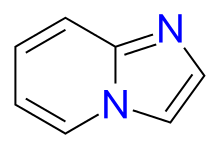Imidazopyridine
An imidazopyridine is a nitrogen containing heterocycle that is also a class of drugs that contain this same chemical substructure. In general, they are GABAA receptor agonists, however recently proton pump inhibitors, aromatase inhibitors, NSAIDs and other classes of drugs in this class have been developed as well. Despite usually being similar to them in effect, they are not chemically related to benzodiazepines. As such, GABAA-agonizing imidazopyridines, pyrazolopyrimidines, and cyclopyrrones are sometimes grouped together and referred to as "nonbenzodiazepines." Imidazopyridines include:

Sedatives
Anxiolytics, sedatives and hypnotics (GABAA receptor positive allosteric modulators):
- Imidazo[1,2-a]pyridines:
- Alpidem (original brand name Ananxyl)—an anxiolytic that was withdrawn from the market worldwide in 1995 due to hepatotoxicity.
- DS-1—a GABAA receptor positive allosteric modulator selective for the α4β3δ subtype, which is not targeted by other GABAergics such as benzodiazepines or other nonbenzodiazepines.[1]
- Necopidem—an anxiolytic. It has not found clinical use.
- Saripidem—a sedative and anxiolytic. It is not used clinically.
- TP-003—a subtype-selective partial agonist at GABAA receptors, binding to GABAA receptor complexes bearing either α2, α3 or α5 subunits, but only showing significant efficacy at α3.
- Zolpidem (original brand name Ambien)—a widely used hypnotic. Generic versions are widely available.
- Imidazo[4,5-c]pyridines:
- Bamaluzole—a GABAA receptor-agonizing anticonvulsant that was never marketed.[2]
Antipsychotic
- Imidazo[1,2-a]pyridines:
- Mosapramine (brand name クレミン, Cremin)—an atypical antipsychotic used in Japan.[3]
Gastrointestinal
Drugs used for peptic ulcer disease (PUD), GERD and gastroprokinetic agents (motility stimulants):
- Imidazo[1,2-a]pyridines:
- CJ-033466—an experimental gastroprokinetic acting as a selective 5-HT4 serotonin receptor partial agonist.[4]
- Zolimidine—a gastroprotective agent.[5]
- Linaprazan—a potassium-competitive acid blocker which demonstrated similar efficacy as esomeprazole in healing and controlling symptoms of GERD patients with erosive esophagitis.[6]
- SCH28080—the prototypical potassium-competitive acid blocker which has not found clinical use because of liver toxicity in animal trials and elevated liver enzyme activity in the serum of human volunteers.[7]
- Imidazo[4,5-b]pyridines:
- Tenatoprazole—it blocks the gastric proton pump leading to decline of gastric acid production.
Anti-inflammatories
NSAIDs, analgesics and antimigraine drugs:
- Imidazo[1,2-a]pyridines:
- Miroprofen—a derivative of propionic acid.
- Imidazo[4,5-b]pyridines:
- Telcagepant—a calcitonin gene-related peptide receptor antagonist which was in clinical trials as a remedy for migraine. Its development was terminated.[8]
Cardiovascular
Drugs acting on the cardiovascular system:
Bone
Drugs for treatment of bone diseases:
- Imidazo[1,2-a]pyridines:
- Minodronic acid (brand names Bonoteo, Recalbon)—a third-generation bisphosphonate used for the treatment of osteoporosis.[10]
Antineoplastic
Antineoplastic agents:
- Imidazo[1,5-a]pyridines:
- Fadrozole (brand name Afema)—an aromatase inhibitor.
- Imidazo[4,5-c]pyridines:
- 3-Deazaneplanocin A—an S-adenosyl-L-homocysteine synthesis inhibitor and histone methyltransferase EZH2 inhibitor.
Antiviral
Directly-acting antiviral agents:
- Imidazo[1,2-a]pyridines:
- Tegobuvir/GS-9190 - an allosteric, non-nucleoside hepatitis C virus NS5B RNA-dependent RNA polymerase inhibitor targeting the thumb II allosteric site.[11]
References
- Wafford KA, van Niel MB, Ma QP, Horridge E, Herd MB, Peden DR, et al. (January 2009). "Novel compounds selectively enhance delta subunit containing GABA A receptors and increase tonic currents in thalamus". Neuropharmacology. 56 (1): 182–9. doi:10.1016/j.neuropharm.2008.08.004. PMID 18762200.
- David J. Triggle (1996). Dictionary of Pharmacological Agents. Boca Raton: Chapman & Hall/CRC. ISBN 0-412-46630-9.
- Takahashi N, Terao T, Oga T, Okada M (1999). "Comparison of risperidone and mosapramine addition to neuroleptic treatment in chronic schizophrenia". Neuropsychobiology. 39 (2): 81–5. doi:10.1159/000026565. PMID 10072664.
- Mikami T, Ochi Y, Suzuki K, Saito T, Sugie Y, Sakakibara M (April 2008). "5-Amino-6-chloro-N-[(1-isobutylpiperidin-4-yl)methyl]-2-methylimidazo[1,2-alpha]pyridine-8-carboxamide (CJ-033,466), a novel and selective 5-hydroxytryptamine4 receptor partial agonist: pharmacological profile in vitro and gastroprokinetic effect in conscious dogs". The Journal of Pharmacology and Experimental Therapeutics. 325 (1): 190–9. doi:10.1124/jpet.107.133850. PMID 18198343.
- Belohlavek D, Malfertheiner P (1979). "The effect of zolimidine, imidazopyridine-derivate, on the duodenal ulcer healing". Scandinavian Journal of Gastroenterology. Supplement. 54: 44. PMID 161649.
- Kahrilas PJ, Dent J, Lauritsen K, Malfertheiner P, Denison H, Franzén S, Hasselgren G (December 2007). "A randomized, comparative study of three doses of AZD0865 and esomeprazole for healing of reflux esophagitis". Clinical Gastroenterology and Hepatology. 5 (12): 1385–91. doi:10.1016/j.cgh.2007.08.014. PMID 17950677.
- Ravinder Reddy S, Basavaraja HS, Shivaprasad S. "Reversible Proton Pump Inhibitors: A Superior Edge — Features". Pharmabiz.com. Saffron Media Pvt. Ltd I. Archived from the original on 5 March 2016. Retrieved 7 December 2015.
- Merck Announces Second Quarter 2011 Financial Results
- Uemura Y, Tanaka S, Ida S, Yuzuriha T (December 1993). "Pharmacokinetic study of loprinone hydrochloride, a new cardiotonic agent, in beagle dogs". The Journal of Pharmacy and Pharmacology. 45 (12): 1077–81. doi:10.1111/j.2042-7158.1993.tb07184.x. PMID 7908977.
- Hegde S, Schmidt M (January 2010). "To market, to market—2009". Annual Reports in Medicinal Chemistry. 45: 466–537. doi:10.1016/s0065-7743(10)45028-9.
- Hebner CM, Han B, Brendza KM, Nash M, Sulfab M, Tian Y, et al. (2012). "The HCV non-nucleoside inhibitor Tegobuvir utilizes a novel mechanism of action to inhibit NS5B polymerase function". PLOS One. 7 (6): e39163. doi:10.1371/journal.pone.0039163. PMC 3374789. PMID 22720059.